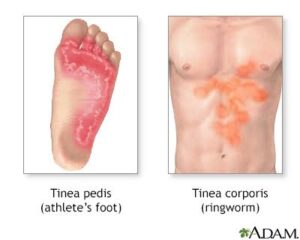Back to: MICROBIOLOGY 300 LEVEL
Welcome to class!
Hello, superstar! It’s so wonderful to have you back in class again. You’ve been showing such great commitment to learning microbiology, and that’s something to truly celebrate. Today, we’re looking at a very important and practical topic—Cryptococcus neoformans and dermatophytes, which are the fungi behind common skin infections like ringworm and athlete’s foot. You may have seen or even experienced some of these infections before, so let’s make this topic simple, human, and easy to relate with.
Cryptococcus Neoformans, Dermatophytes (Ringworm, Athlete’s Foot)
You know how sometimes people develop itchy, round patches on their skin, or their feet get flaky and uncomfortable in tight shoes? These could be caused by fungi called dermatophytes. On the other hand, Cryptococcus neoformans is a more serious fungus that affects people with weak immune systems, often targeting the brain. These two types of fungi behave very differently but are both important in medical microbiology.

Let’s get to know each of them better.
Cryptococcus neoformans
Cryptococcus neoformans is a yeast-like fungus.
It is found in soil contaminated with bird droppings, especially pigeon droppings.
People usually inhale the fungal spores from the air.
It is opportunistic, meaning it mainly causes illness in people with weakened immune systems—like those living with HIV/AIDS, cancer, or transplant patients.
Diseases Caused
The most serious condition caused by this fungus is cryptococcal meningitis—an infection of the membranes covering the brain and spinal cord.
Symptoms include headache, fever, stiff neck, confusion, and sensitivity to light.
Diagnosis and Treatment
Diagnosed using cerebrospinal fluid tests (CSF analysis, India ink staining, antigen tests).
Treated with antifungal drugs like amphotericin B and fluconazole.
Dermatophytes: Ringworm and Athlete’s Foot
Now, to something you’ve probably seen before! Dermatophytes are fungi that infect the skin, hair, and nails. They love warm, moist environments like sweaty shoes, public showers, and shared towels.
Common Dermatophyte Infections
Tinea corporis (Ringworm)
Appears as a red, circular, itchy patch on the body.
Despite the name, there’s no actual worm involved—just fungus!
Tinea pedis (Athlete’s Foot)
Affects the feet, especially between the toes.
Causes itching, scaling, and cracked skin.
Common in people who wear tight shoes or don’t dry their feet properly.
Tinea capitis (Scalp ringworm)
Affects the scalp, especially in children.
Leads to patchy hair loss, itching, and scaling.
Diagnosis and Treatment
Diagnosed by examining skin scrapings under a microscope and culturing them.
Treated with topical antifungals like clotrimazole, or oral antifungals for deeper infections.

Think of your body as a house. If the roof is strong (like your immune system), rainwater (fungal spores) won’t cause any damage. But if the roof is leaking, that water can seep in and cause serious problems—just like how Cryptococcus neoformans takes advantage of weak immunity. On the other hand, dermatophytes are like muddy footprints—easily picked up from the environment but often just on the surface, especially when things are warm and damp.
Summary
- Cryptococcus neoformans is a yeast that causes serious infections like meningitis in people with low immunity.
- It is found in bird droppings and enters the body through inhalation.
- Dermatophytes are fungi that infect the skin, hair, and nails, causing conditions like ringworm and athlete’s foot.
- They are spread through direct contact or contaminated surfaces.
- Both types are treated with antifungal medications, and diagnosis often involves microscopy and fungal culture.
Evaluation
- How does Cryptococcus neoformans usually enter the human body?
- Who is most at risk of developing cryptococcal meningitis?
- What causes the condition known as ringworm?
- List two ways athlete’s foot can be prevented.
- Name one medicine used to treat fungal skin infections.
Well done, champ! You’ve just mastered another exciting and practical part of microbiology. This knowledge is powerful—not just for exams but for real life too. Whether it’s helping someone spot a skin infection or understanding how fungi can affect the brain, you are building skills that matter. Keep shining, and remember—Afrilearn is always here to walk with you. See you in our next class, genius!
